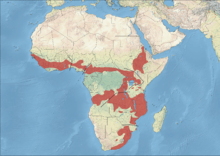African firefinch
| African firefinch | |
|---|---|
.jpg) | |
| Scientific classification | |
| Kingdom: | Animalia |
| Phylum: | Chordata |
| Class: | Aves |
| Order: | Passeriformes |
| Family: | Estrildidae |
| Genus: | Lagonosticta |
| Species: | L. rubricata |
| Binomial name | |
| Lagonosticta rubricata (Lichtenstein, 1823)[2] | |
 | |
| The distribution of the African firefinch | |
The African firefinch (Lagonosticta rubricata), also called the dark firefinch or blue-billed firefinch due to the color of its bill,[3] is a common species of estrildid finch found in almost all parts of Africa. It has an estimated global extent of occurrence of 5,400,000 km2.
Description
The African firefinch is a small red or red and brown species of estrildid finch. The male has a lead grey crown, nape and neck, merging on to an olive brown mantles with the scapulars, wing coverts and tertials also olive brown, sometimes with a grey tinge. The rump, uppertail coverts, outer tail fathers are deep carmine red, the rest of the tail is black. The underparts from the chin to the belly are deep scarlet, with small white spots on the upper breast and flanks, the scarlet of the flanks continues to the side of the rump. The centre of the belly is greyish becoming black on the vent and the undertail coverts. the short, pointed bill is blackish-grey with a pink base to the lower mandible. Females are similar to the male but they are less intensely coloured, juveniles lack any red on the underparts.[4] The African firefinch measures 10–11 cm in length and weighs 8.6-11.7g.[5]
Voice
The song of the African firefinch, which is given by both sexes, is made up of various ringing notes which are randomly repeated and interspersed with squeaky whistle, trills and warbles. The alarm call is a harsh ticking which resembles the scolding call of the Eurasian wren. more usual calls are rising trilling twitter " trrrrrrrr-t" and a lowd clear "tui-tui-tui-tui", which is often followed by "wink-wink-wink".[4]
Distribution
The African firefinch occurs in patches across sub-Saharan Africa, from Senegal east to Ethiopia then south to the southern Democratic Republic of Congo and Tanzania south through Mozambique to the Eastern Cape province of South Africa.[6]
Habitat
The African firefinch generally prefers humid, thickly vegetated habitats such as bracken Pteridium aquilinum at forest edges, savanna with acacia woodland, rank grass within and belowscrub or thornbush, along streams and rivers with thick vegetation, often near quiet paths or roads. The African firefinch can also be seen in and around gardens and rural villages but not as commonly as some other firefinch species.[4][6]
Habits
The African firefinch mainly feeds on seeds which are supplemented with insects, it mostly forages on the ground, searching through the soil looking for food.[6] It occurs in pairs or small family parties and may mix with other firefinches, staying close to cover and retreating quickly into the cover if alarmed.[4]
The male African firefinch builds the nest, which is a round structure with a side entrance, the outer shell consists of long, dry grass blades and there is an inner shell of soft grass inflorescences, this is sometimes lined with feathers. The nest is typically hidden deep in long, thick grass, bracken-briar undergrowth or in grass growing among fallen branches or tree stumps. The 2-5 eggs are laid, in southern Africa, from November–June, with a peak from January–April, further north it breeds later in the year.[5] Both sexes incubate the eggs, incubation lasting about 12 days, once hatched the chicks are fed both parents for 2–3 weeks up to fledging, after which they are fed for 10 more days at which point they become fully independent.[6] The dusky indigobird is a brood parasite of the African firefinch.[4]
Taxonomy
Four subspecies of the African firefinch are currently recognised[2] and they are set out below with their distributions:[5]
- Lagonosticta rubricata polionota Shelley, 1873: southern Senegal, south western Mali, Guinea-Bissau, Guinea, Sierra Leone and northern Liberia east to Nigeria.
- Lagonosticta rubricata congica Sharpe, 1890: Cameroon east to South Sudan, north eastern Democratic Republic of Congo and western Uganda, south to Gabon and northern and north eastern Angola.
- Lagonosticta rubricata haematocephala Neumann, 1907: East Africa from Sudan east of the River Nile, Ethiopia, Uganda, and the Kenya Highlands south to Zambia, Malawi, Eastern Highlands of Zimbabwe, coastal Tanzania and north and central Mozambique, north of the Save River.
- Lagonosticta rubricata rubricata (M. H. C. Lichtenstein, 1823):Northern and eastern South Africa, Swaziland and southern Mozambique.
The pale-billed firefinch Lagnosticta landanae of western Angola, Cabinda and the western Democratic Republic of Congo is sometimes considered a fifth subspecies of African firefinch. Molecular studies have shown is being more closely related to the nominate subspecies than to any of the other subspecies but it shares some morphological features with L.r. congica.[5]
References
- ↑ BirdLife International (2012). "Lagonosticta rubricata". IUCN Red List of Threatened Species. Version 2013.2. International Union for Conservation of Nature. Retrieved 26 November 2013.
- 1 2 "Lagonosticta rubricata (Lichtenstein, 1823)". Integrated Taxonomic Information System (ITIS) (http://www.itis.gov). Retrieved 2016-11-07.
- ↑ African Firefinch Lagonosticta rubricata Mangoverde World Bird Guide
- 1 2 3 4 5 Clement, Peter; Harris, Alan; David, John (1993). Finches & Sparrows. Christopher Helm. pp. 356–357. ISBN 0-7136-8017-2.
- 1 2 3 4 "African Firefinch (Lagonosticta rubricata)". Handbook of the Birds of the World Alive. Lynx Edicions. Retrieved 2016-11-07.
- 1 2 3 4 "Lagonosticta rubricata (African firefinch, Blue-billed firefinch)". Biodiversity Explorer. Iziko Museums of South Africa. Retrieved 2016-11-07.
